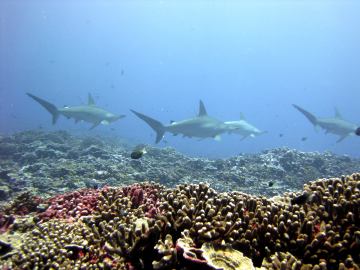SATS print 223_360 px width.png

Female hammerhead sharks have been observed in large numbers at two atolls in French Polynesia during the summer, coinciding with the full moon. This raises questions as to why they are congregating. Credit: Kevin Lino NOAA/NMFS/PIFSC/ESD
Sometimes scientific discoveries answer questions scientists have wondered about for years, but more often, a discovery simply raises dozens of new questions to explore. For example, why on earth do dozens of female great hammerhead sharks gather at two atolls in French Polynesia around the full moon each summer? While we don’t know the reason right now, the observation opens the door to more research to uncover the mysteries of this severely endangered species.
Great hammerheads are typically solitary, so it’s especially noteworthy if many gather in one place. Yet that’s what scientists observed in the Southern Hemisphere summers of 2020 and 2021 around Rangiroa and Tikehau, two atolls in the Tuamotu archipelago of French Polynesia. Biologists observed 54 female great hammerheads independently roaming the bottom of “hammerhead plateau,” about 150-200 feet deep. And at least 32 of these sharks have been visiting the same atoll for up to 12 years.
Although the sharks didn’t appear to interact with one another, their numbers were highest just before and after the full moon, suggesting some link between the lunar cycle and their reasons for visiting. The question is, what might that link be? Maybe brighter moonlight made it easier for them to hunt the ocellated eagle rays that gather to mate in the area each summer. Or maybe the hammerheads are attracted to the warmer water temperatures. Or perhaps shifts in the Earth’s geomagnetic field triggered by the moon’s waxing and waning somehow lure the sharks in, since some sharks may use the Earth’s magnetic field for navigation. Or, since they’re all females, could the area be a shark nursery? Scientists don’t have these answers yet, but asking these questions can help lead them toward even more discoveries.


